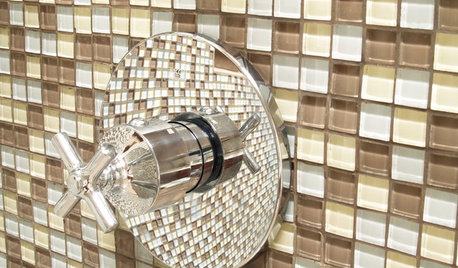Where are the valves?
sreeram_tx
18 years ago
Related Stories

BATHROOM DESIGNBath Remodeling: So, Where to Put the Toilet?
There's a lot to consider: paneling, baseboards, shower door. Before you install the toilet, get situated with these tips
Full Story
HOUZZ TOURSHouzz Tour: 1960s Ranch Redo in Denver
This sibling team balanced their renovation budget by spending where it counts, and turned their Colorado childhood home into a showplace
Full Story
UNIVERSAL DESIGNAging-in-Place Resolutions for the New Year
How to make your home help you age gracefully right where you are
Full Story
BATHROOM DESIGN12 Things to Consider for Your Bathroom Remodel
Maybe a tub doesn’t float your boat, but having no threshold is a no-brainer. These points to ponder will help you plan
Full Story
HOUZZ TOURSNautilus Studio: Creative Living in 600 Square Feet
Two Seattle artists turn a tiny storage space into their ultimate canvas
Full Story
BATHROOM DESIGNConvert Your Tub Space to a Shower — the Fixtures-Shopping Phase
Step 2 in swapping your tub for a sleek new shower: Determine your mechanical needs and buy quality fixtures
Full Story
LIFE7 Things to Do Before You Move Into a New House
Get life in a new house off to a great start with fresh paint and switch plates, new locks, a deep cleaning — and something on those windows
Full Story
TRADITIONAL ARCHITECTUREHow to Research Your Home's History
Learn what your house looked like in a previous life to make updates that fit — or just for fun
Full Story
BATHROOM DESIGN4 Secrets to a Luxurious Bathroom Look
Give your bathroom a finished feel with a few splurges and budget-stretching moves
Full Story
GREEN BUILDINGHow to Harvest Rainwater for Your Garden
Conserve a vital resource and save money by collecting stormwater for irrigation in a barrel or tank
Full StoryMore Discussions







van027
dmullen
Related Professionals
Beachwood Landscape Architects & Landscape Designers · Camas Landscape Architects & Landscape Designers · Saint Charles Landscape Architects & Landscape Designers · Woodinville Landscape Architects & Landscape Designers · Waterbury Landscape Contractors · Cedar Hill Landscape Contractors · Gallatin Landscape Contractors · Golden Gate Landscape Contractors · Nutley Landscape Contractors · Old Saybrook Landscape Contractors · Rancho Santa Margarita Landscape Contractors · Severna Park Landscape Contractors · Wailuku Landscape Contractors · Albany Solar Energy Systems · Hayward Solar Energy Systemssreeram_txOriginal Author
more_to_grow
sreeram_txOriginal Author
dmullen
sreeram_txOriginal Author
more_to_grow
sreeram_txOriginal Author
purewater_2007
Kmykimi_2
lehua49